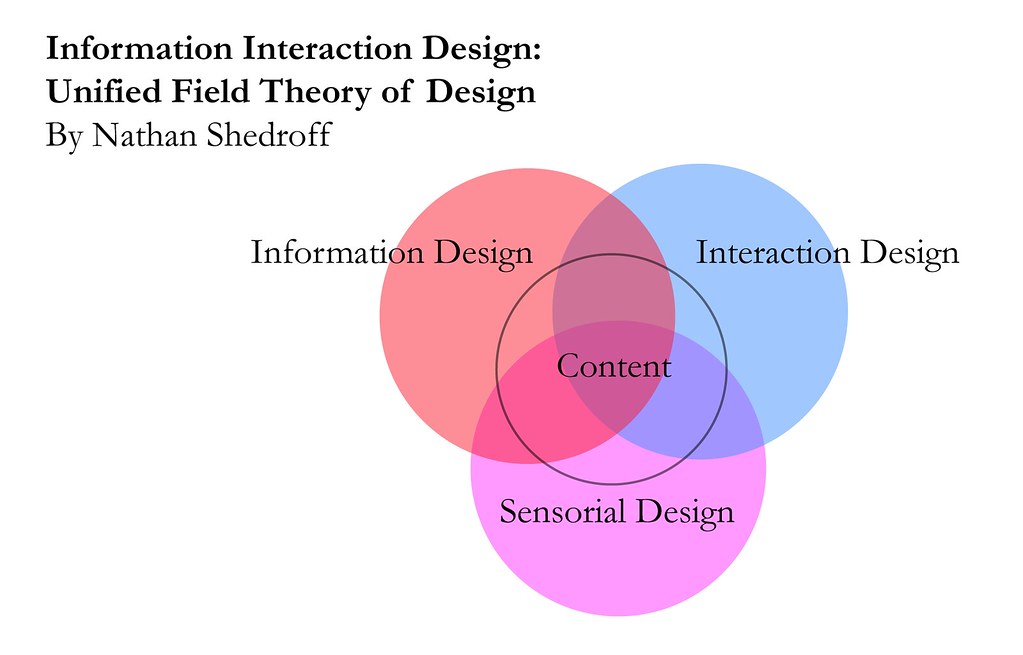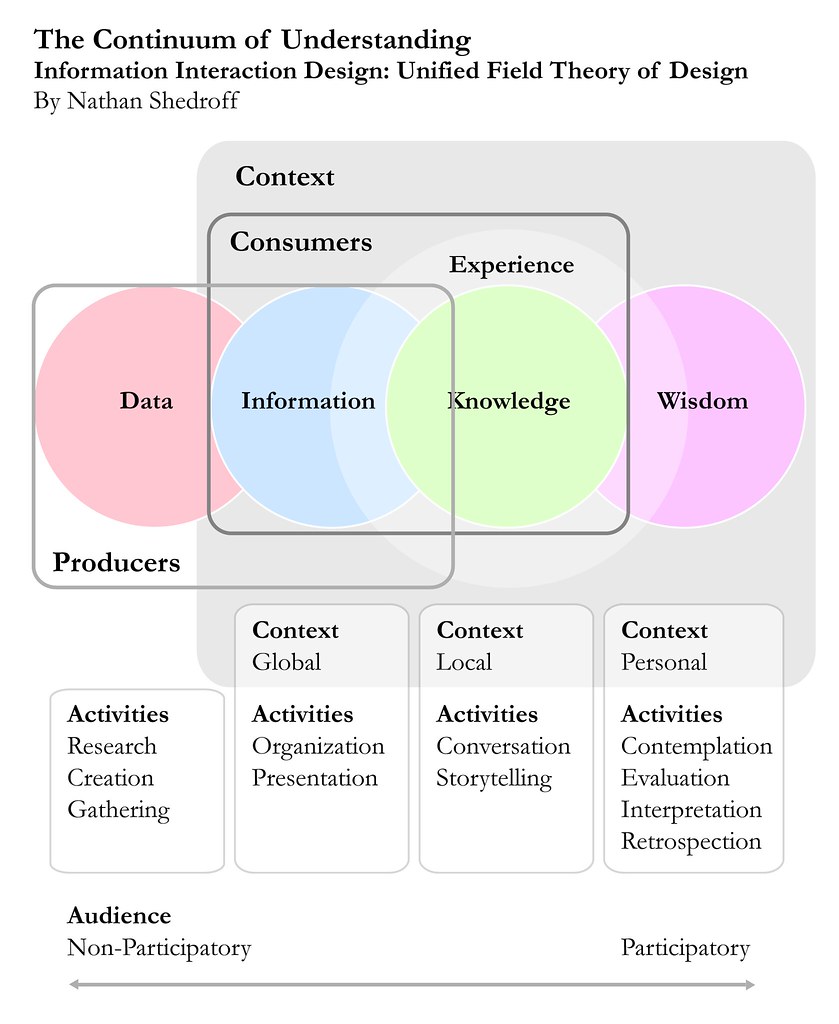The intent of this theory is to enable people to create “valuable, compelling, and empowering information and experiences for others.” (Shedroff believes that these design skill are crucial for success in modern society.) In order to create these experiences people need to have a message and a reason for communicating it
The relationship between information, interaction and sensorial design disciplines is visualized as a Venn diagram. Each discipline encompasses different types of expertise. To create compelling content and engaging experiences designers need to bring to bear skills from all of these realms.
I classify this theory as an experience design framework because it brings together all disciplines required to created compelling communications and engaging experiences. Nathan has developed other valuable experience design-focused frameworks that I will explore in future posts.
First off, I’ll provide and overview of Shedroff’s definition for information, interaction, and sensorial design. Then I’ll delve deeper into each of these disciplines to explore relevant concepts and frameworks.
Overview of Information, Interaction, and Sensorial Design
- “Information design addresses the organization and presentation of data: its transformation into valuable, meaningful information.” Information design has been practiced by graphic designers and publishers for a long time, though they rarely identified these practices as a distinct discipline. Recently this discipline has become more importance due to the proliferation of data, and the need to synthesize this data into information, knowledge, and ultimately wisdom.
- Interaction design is “essentially story-creating and telling, [that] is both an ancient art and a new technology.” Interaction design for many traditional media such as print, TV and outdoor is limited and guided by existing conventions. Interaction design has long been practiced by industrial designers and live performers, though they did not identify it as its own discipline. The new possibilities for interaction offered by interactive technologies have increased the importance of interaction design.
- “Sensorial design is simply the employment of all techniques with which we communicate to others through our senses.” This includes writing, visual techniques (e.g. graphic design, animations, and videography), sounds, smells, tactile feel (e.g. industrial design, and material selection). Sensorial design disciplines have their own histories, concerns and practices. The traditional focus of most design disciplines is on sensorial design. That said, most great designers had an understanding regarding information and interaction design, even if they did not recognize these practices as distinct disciplines.
“An understanding of information design starts with the essential view that the vast amount of things that bombard our senses everyday are not pieces of information but merely data.” To transform data into information it needs to be organized, and presented in an appropriate context that can give it meaning. Information can be consumed via experiences that generate knowledge. Experiences can then eventually generate wisdom.
The Continuum of Understanding
Data and information are both part of a continuum of understanding. This continuum maps the relationship between four different levels of understanding: data, information, knowledge, and wisdom.
Data represents the lowest level of understanding along this continuum. It is the “raw material we find or create” to build our communications. By itself data does not contain a complete message and is inconsequential and boring. For these reasons data is mostly useful to people who produce content.
Data is transformed into information when it is organized and presented in a context that makes relationships and patterns visible and delivers meaning. Producers of information determine what data is used guided by their own goals and conceptual models. On the other hand, consumers determine how the information is consumed and evaluated according to their own goals and mental models.
The next ladder up on the continuum is knowledge. Knowledge refers to the understanding that we gain through experience. It is created by the integration of information with our existing mental models and understandings. Knowledge is participatory level of communication that can be individual or shared. As such, it can only be communicated through compelling interactions that enable people to identify patterns and meanings in information.
The highest, most intimate and vague level of understanding is Wisdom. Less is known about it than any other level, other than it is more abstract and philosophical. “Wisdom is a kind of ‘meta-knowledge’ of processes and relationships gained through experiences. It is the result of contemplation, evaluation, retrospection, and interpretation – all of which are particularly personal processes.” Unlike knowledge, wisdom is hard to share, and occurs at an individual level only.
Organization, Metaphors and Goals
Organization is the first step in the process of transforming data into information, so that it can be communicated effectively. This is a crucial activity because the organization of data impacts the way information is understood and interpreted by others. Shedroff identifies several common ways to organize information: Alphabets, Locations, Time, Continuums, Numbers, Categories, Randomness, Advanced Organizations, and Multiple Organizations.
Metaphors can also help transform data into information because they can enable people to quickly understand relationships and meanings. That said, when metaphors are used poorly (as they often are) they can worsen the user experience and limit the possibilities for progress associated to the design of information, interactions and senses.
Definition of objectives and messages is a crucial strategic step in the development of effective communications. All design decisions should be guided by pre-defined goals and messaging considerations.
Interaction Design
Interaction design is focused on the creation of experiences that are appropriate, effective, delightful, and even wonderful. Traditionally, the design of interactions has been practiced mostly in the performing arts such through disciplines such as script-writing, storytelling, performance, and instructional design. More recently, interaction design has become a key practice associated to the development of computer-based products and services.
Continuum of Interactivity
Nathan offers an interesting perspective on interactivity: “One way to consider the meaning of interactivity is to envision all experiences (and products) as inhabiting a continuum of interactivity.” This continuum ranges from passive experiences to interactive ones. There are six main attributes that can differentiate interactive experiences from passive ones. Interactive experiences offer the user with clear feedback, enhanced control, and additional opportunities for creativity, productivity, communication, or adaptability.
Feedback and control are closely related. All experiences with high interactivity provide high levels of feedback and a minimum level of control. Feedback enables the person interacting with a device to perceive (and hopefully understand) the impact of their actions. Control enables that same person to carry out actions on, and through, the device.
Creativity and productivity are two attributes of interactivity that are related to making, doing, and sharing things. Highly interactive experiences are better able to support creativity and productivity than passive ones. For example, guitar lessons available on the new Garage Band are more effective educational tools than those available via most books because they are more interactive.
Communication is an attribute of interactivity that is focused on enabling people to meet people, talk to others and share opinions and stories. By definition, experiences that support communication provide a high-level of feedback and control.
Adaptivity is the final attribute of interactivity explored by Shedroff. It is related to the adaptation of a system in response to changes in user behavior or context. Highly interactive experiences often provide features such as agents and additional tools and functionality based on user behavior or context. For example, video games get harder as the player gets better and progresses through different phases and reaches new milestones.
To help visualize different activities across these various attributes of interactivity, Shedroff developed an experience cube (a simplified version of a six-sided diagram that was originally attempted). This cube maps feedback and control as a single dimension, next creativity, productivity and communication are grouped as another dimension, adaptivity remains its own dimension. Any experience, whether computer mediated or not, can be mapped within this cube.
Sensorial Design
Sensorial design encompasses all disciplines related to the creation and presentation of media – graphic design, sound design, photography, animation, calligraphy, typography, cinematography, illustration, etc. This includes any design endeavor associated to the purposeful stimulation of the senses: tactile, visual, olfactory, or auditory. All of these disciplines share a few common concerns: a focus on understanding human senses; and a concern with the appropriate use of media, style, and technique.
[This information is sourced from a paper by Nathan Shedroff titled: Information Interaction Design: A Unified Field Theory of Design ]



No comments:
Post a Comment